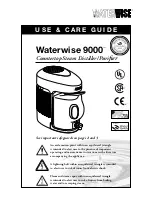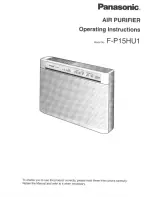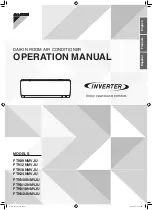
Page 21
Installation, Operation & Maintenance Manual ( IOPCKKS60220510C1)
SHUT DOWN
1.
Set the thermostat to highest temperature setting.
2.
Turn off the electrical power to the unit.
BELT DRIVE BLOWER
All units have belt drive single speed blower motors. The variable
pitch pulley on the blower motor can be adjusted to obtain the
desired supply air CFM. For high static requirement (DMS 480 &
600), fixed pitch pulleys will be provided.
TROUBLE SHOOTING
COOLING TROUBLE SHOOTING GUIDE
WARNING
TROUBLESHOOTING OF COMPONENTS MAY REQUIRE
OPENING THE ELECTRICAL CONTROL BOX WITH THE
POWER CONNECTED TO THE UNIT. USE EXTREME CARE
WHEN WORKING WITH LIVE CIRCUITS! CHECK THE UNIT
NAMEPLATE FOR THE CORRECT LINE VOLTAGE AND
SET THE VOLTMETER TO THE CORRECT RANGE BEFORE
MAKING ANY CONNECTIONS WITH LINE TERMINALS.
Troubleshooting of components may require opening the electrical
control box with the power connected to the unit. Use extreme
care when working with live circuits! Check the unit nameplate for
the correct line voltage and set the voltmeter to the correct range
before making any connections with line terminals.
When not necessary, shut off all electric power to the unit prior
to any of the following maintenance procedures so as to prevent
personal injury.
CAUTION
LABEL ALL WIRES PRIOR TO DISCONNECTION WHEN
SERVICING CONTROLS. WIRING ERRORS CAN CAUSE
IMPROPER AND DANGEROUS OPERATION, WHICH
COULD CAUSE INJURY TO PERSON AND/OR DAMAGE
UNIT COMPONENTS. VERIFY PROPER OPERATION
AFTER SERVICING.
* On calls for cooling, if the compressors are operating but
the supply air blower motor does not energize after a short
delay (the room thermostat fan switch is in the “AUTO”
position).
1.
Turn the thermostat fan switch to the ON position. If the
supply air blower motor does not energize, go to Step 3.
2.
If the blower motor runs with the fan switch in the ON position
but will not run after the first compressor has energized
when the fan switch is in the AUTO position, check the room
thermostat for contact between R and G in the AUTO position
during calls for cooling.
3.
If the supply air blower motor does not energize when the fan
switch is set to ON, check that line voltage is being supplied
to the blower contactor, and that the contactor is pulled in.
Check for loose wiring between the contactor and the supply
air blower motor.
4.
If blower contactor is pulled in and voltage is supplied to
contactor, lightly touch the supply air blower motor housing.
If it is hot, the motor may be off on internal protection. Cancel
any thermostat calls and set the fan switch to AUTO. Wait for
the internal overload to reset. Test again when cool.
5.
If blower contactor is not pulled in, check for 24 volts at the
contactor coil. If 24 volts are present but it is not pulled in,
replace the contactor.
6.
Failing the above, if there is line voltage supplied at contactor
and it is pulled in, and the supply air blower motor still does
not operate, replace the motor.
7.
If 24 volts is not present at blower contactor, check that 24
volts is present at the UCB supply air blower motor terminal,
“FAN”. If 24 volts is present at the FAN, check for loose wiring
between the UCB and blower contactor.
8.
If 24 volts is not present at the “FAN” terminal, check for
24 volts from the room thermostat. If 24 volts are not
present from the room thermostat, check for the following :
a. Proper operation of the room thermostat (contact
between R and G with the fan switch in the ON position
and in the AUTO position during operation calls),
b. Proper wiring between the room thermostat and the UCB, and
c. Loose wiring from the room thermostat to the UCB.
9.
If 24 volts is present at the room thermostat but not at the
UCB, check for proper wiring between the thermostat and the
UCB, i.e. that the thermostat G terminal is connected to the G
terminal of the UCB, and for loose wiring.
10.
If the thermostat and UCB are properly wired, replace the
UCB.
On calls for cooling, the supply air blower motor is operating
but compressor # 1 is not (the room thermostat fan switch is
in the “AUTO” position).
1.
If compressor # 1 does not energize on a call for cooling,
check for line voltage at the compressor contactor 1, and that
the contactor is pulled in. Check for loose wiring between the
contactor and the compressor.
2.
If compressor contactor 1 is pulled in and voltage is
supplied, lightly touch the compressor housing. If it ishot, the
compressor may be off on inherent protection. Cancel any
calls for cooling and wait for the internal overload to reset.
Test again when cool.
3.
If compressor contactor 1 is not pulled in, check for 24 volts
at the coil. If 24 volts are present and contactor is not pulled
in, replace the contactor.
4.
Failing the above, if voltage is supplied at compressor
contactor 1, it is pulled in, and the compressor still does not
operate, replace the compressor.
5.
If 24 volts is not present at compressor contactor 1, check for
24 volts at the UCB terminal, C1. If 24 volts is present, check
for loose wiring between C1 and the compressor contactor.
6.
If 24 volts is not present at the C1 terminal, check for 24
volts from the room thermostat at the UCB Y1 terminal. If 24
volts is not present from the room thermostat, check for the
following :
tWPMUTBUUIFUIFSNPTUBU:UFSNJOBM








































